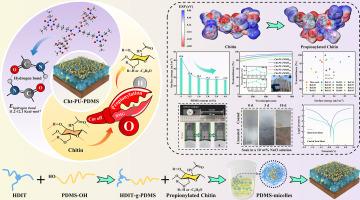Hydrogen-bond network reconstruction driven transparent α-chitin polyurethane coatings for eco-friendly surface protection: Synergistic antifouling and anticorrosion enhancement
IF 7.3
2区 材料科学
Q1 CHEMISTRY, APPLIED
引用次数: 0
Abstract
α-Chitin, as a natural bio-based polyol, possesses significant potential in bio-based green coatings. However, its intractable solubility and poor processability resulting from robust intermolecular hydrogen bonding and high crystallinity have long impeded the development and application of high-performance, environmentally friendly biomass coatings. To address this challenge, we propose a novel “hydrogen-bond network reconstruction” strategy. Through physicochemical co-modification disrupting chitin's microstructure, we successfully overcame its solubility barrier. Using this highly soluble chitin as the matrix and integrating flexible polydimethylsiloxane (PDMS) with hexamethylene diisocyanate trimer (HDIT) crosslinking technology, we fabricated an omniphobic coating with exceptional comprehensive properties. This coating exhibits an ultra-low surface energy (17 mJ·m−2, lower than PTFE) and a densely cross-linked network, demonstrating not only superhydrophobicity/superoleophobicity with high contact angles (water: 110.7 ± 0.8°, diiodomethane: 80.9 ± 1.9°), excellent self-cleaning capability, and efficient anti-fouling/anti-graffiti properties, but also, owing to its reinforced network structure, remarkable mechanical stability (6H pencil hardness, A1-grade adhesion, abrasion resistance) and chemical resistance (tolerance to chemical agents, no corrosion after 10-day saline immersion, 20-fold reduction in corrosion current density (Icorr) compared to bare iron). Simultaneously, it maintains high optical transparency (95 %). This coating provides a green, durable, and easy-to-maintain protective solution for precision devices such as electronic displays and solar panels, significantly extending service life while reducing cleaning energy consumption. This work establishes a foundation for developing high-performance biomass coatings integrating both ecological sustainability and industrial value via “hydrogen-bond network reconstruction” and green manufacturing pathways.

氢键网络重构驱动的透明α-几丁质聚氨酯涂料,用于环保表面保护:协同防污和防腐增强
α-几丁质作为一种天然的生物基多元醇,在生物基绿色涂料中具有重要的应用潜力。然而,由于分子间氢键牢固,结晶度高,其难溶解性和加工性差,长期以来阻碍了高性能、环保型生物质涂料的开发和应用。为了应对这一挑战,我们提出了一种新的“氢键网络重建”策略。通过物理化学共改性破坏甲壳素的微观结构,我们成功地克服了甲壳素的溶解度障碍。以高可溶性甲壳素为基体,将柔性聚二甲基硅氧烷(PDMS)与六亚甲基二异氰酸酯三聚体(HDIT)交联技术相结合,制备了综合性能优异的全疏涂层。该涂层具有超低的表面能(17 mJ·m−2,低于PTFE)和密集的交联网络,不仅具有高接触角(水:110.7±0.8°,二硫甲烷:80.9±1.9°),优异的自清洁能力,高效的防污/防涂鸦性能,而且由于其增强的网络结构,具有卓越的机械稳定性(6H铅笔硬度,a1级附着力,耐磨性)和耐化学性(耐化学剂,盐水浸泡10天后不腐蚀,腐蚀电流密度(Icorr)比裸铁降低20倍)。同时,它保持了很高的光学透明度(95%)。该涂层为电子显示器和太阳能电池板等精密设备提供了绿色,耐用,易于维护的保护解决方案,可显着延长使用寿命,同时降低清洁能耗。这项工作为通过“氢键网络重建”和绿色制造途径开发集生态可持续性和工业价值于一体的高性能生物质涂料奠定了基础。
本文章由计算机程序翻译,如有差异,请以英文原文为准。
求助全文
约1分钟内获得全文
求助全文
来源期刊

Progress in Organic Coatings
工程技术-材料科学:膜
CiteScore
11.40
自引率
15.20%
发文量
577
审稿时长
48 days
期刊介绍:
The aim of this international journal is to analyse and publicise the progress and current state of knowledge in the field of organic coatings and related materials. The Editors and the Editorial Board members will solicit both review and research papers from academic and industrial scientists who are actively engaged in research and development or, in the case of review papers, have extensive experience in the subject to be reviewed. Unsolicited manuscripts will be accepted if they meet the journal''s requirements. The journal publishes papers dealing with such subjects as:
• Chemical, physical and technological properties of organic coatings and related materials
• Problems and methods of preparation, manufacture and application of these materials
• Performance, testing and analysis.
 求助内容:
求助内容: 应助结果提醒方式:
应助结果提醒方式:


